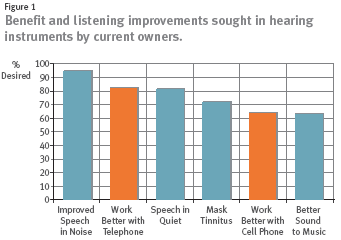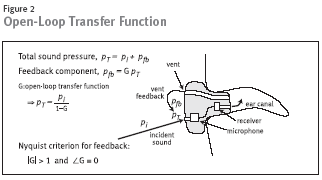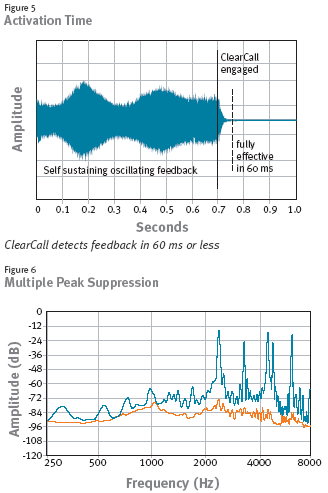View PDF Brochure
ClearCall
A Unique Telephone Solution
Executive Summary
Telephone use is still one of the biggest complaints for three-quarters of all hearing aid users. They want to use the telephone as effectively and conveniently with a hearing aid as they do without a hearing aid. Many hearing aids offer options that allow people with hearing loss to use the telephone without causing feedback; however, these additional devices are often so inconvenient that many people remove their hearing aids before they reach for the handset. Several approaches, with varying degrees of success, have been developed to control telephone-induced feedback and to make using the telephone more comfortable. ClearCall technology was designed to inhibit telephone-induced acoustic feedback automatically. This is accomplished by the combination of multiple peak suppression and
extremely fast activation time. The goal of ClearCall is to allow people with hearing loss to use the telephone or cell phone in a natural and convenient way without the need of additional equipment or any adjustments to the hearing instrument.
Telephones and Hearing Aids: Inventions and Odds
Alexander Graham Bell is best known for his invention of the telephone. He developed the "harmonic telegraph" with the intention of joining people together wherever they were. Along with the telephone, Bell worked toward the development of an early electronic hearing aid. Interestingly, many incompatibility issues have arisen between these two inventions.
The Incompatibility Issue
The MarkeTrak VI survey by Sergei Kochkin1 measured consumer satisfaction in 14 listening situations. Figure 1 reveals clearly that only four in ten consumers are satisfied with their instruments on the telephone and only one in four is satisfied with their hearing instruments on a cell phone. In fact, large group situations are the only category where more hearing aid wearers registered dissatisfaction than they did with the telephone. Similarly, Sanford2 found that 2/3 of home or office phone users and 3/4 of cell phone users felt that the sound clarity of their phone was only fair or poor. High levels of dissatisfaction result from a hearing aid wearer's inability to simply pick up a telephone and start talking on it like everyone else. Placing a telephone next to a hearing aid invariably causes the aid to go into oscillating, whistling, acoustic feedback. Even well fitted hearing aids that rarely feedback during normal operation will begin to squeal when a telephone is placed adjacent to the vent and microphone. Once the instrument has gone into oscillation the problem typically escalates. The initial feedback peak gathers energy and amplitude, producing an intense narrow peak. Secondary oscillations begin to occur at the harmonics of the primary feedback frequency resulting in spikes at multiple frequencies.

Most hearing aid wearers are unhappy with telephone use.
The Problem of Telephone-Induced Feedback
Telephone-induced acoustic feedback is clearly described in a study by Daigle and Stinson. They found that a telephone receiver changes the acoustic field near the hearing instrument microphone. Placing a hand near the hearing aid leads to the same result. In both instances, the variation of the acoustic near field leads to an increase in the open loop transfer function in different frequency ranges. Higher open loop transfers raise the likelihood that acoustic feedback will drive the hearing aid into oscillation and whistling. This open loop transfer function describes the frequency
response of the hearing aid receiver as its output escapes back to the microphone. Earmold venting and slit leakage of amplified sound between the earmold and the wall of the ear canal are the major contributors to the feedback component of the open-loop transfer function.

Graphic depiction of the components of the open-loop transfer function.
A simplified mathematic description of the open loop transfer function is shown in figure 2. There are three basic components that determine its numeric value: the incident sound pressure at the microphone (pi), the gain of the instrument (G) and the amount of sound that leaks back from the receiver to the microphone (pfb). Raising the value of any one of the three increases the amount of the open loop transfer function, and therefore, reduces the stability of the hearing aid. As the stability of the hearing aid decreases, the likelihood increases that it will begin to oscillate and whistle.

Figures 3 and 4 show the proximity effect (variation of the open loop transfer function) of a telephone handset on different hearing instrument styles.
An increase of the transfer function by 10 dB will reduce the feedback limit by 10 dB. If an instrument does not have the additional feedback reserve of 10 dB, the hearing aid will start to feedback.
As the handset moves closer to the hearing aid (from 50 mm away to 0 mm away) the magnitude of the open-loop transfer increases. The increase for the ITE in figure 3 is most pronounced at 2600 Hz. The largest increase for the BTE occurs closer to 3000 Hz and again near 5700 Hz. In general, any frequency where the open-loop transfer magnitude increases in the presence of the handset could be prone to oscillation. The change in the open loop transfer function occurs across several frequency ranges in each figure. The presence of the telephone handset can cause oscillations at many of these frequencies simultaneously. This means that the wearer of a multi-channel hearing instrument may experience feedback peaks in several channels simultaneously while trying to talk on the telephone. Therefore, any truly telephone compatible hearing aid must be able to simultaneously suppress feedback peaks at several different frequencies.
Controlling Telephone-Induced Feedback
Approaches
Several approaches have been developed to control telephone-induced feedback and make telephone use more comfortable for hearing aid wearers. These include such things as handset amplifiers and foam pads to allow the caller to be heard with the handset held away from the hearing aid. Programmable hearing aids may have a special telephone program that provides limited amplification outside the bandpass range of the telephone handset. However, the most common solution to the problem has been to use a telecoil. The telecoil in a hearing aid breaks up the acoustic feedback pathway by disabling the hearing aid microphone and picking up the telephone signal through magnetic induction. A telecoil may be used on its own or in addition to a secondary magnetic coupling
device designed to further boost the intensity of the signal. Any of these approaches can minimize telephoneinduced acoustic feedback with a given individual; however, no one method is appropriate or effective for everyone.
Limitations
Handset amplifiers and foam pads are designed to provide some distance between the earpiece of the handset and the hearing aid microphone. They are both an integral part of a specific telephone handset, cannot conveniently be moved to any other telephone, and are not readily compatible with mobile telephones.
The provision of a special telephone program requires a multi-memory hearing aid and the use of a push button or toggle switch on the hearing aid. The switch must be tampered with before picking up the handset, after putting down the handset and anytime it is inadvertently pressed by the handset while talking on the telephone. Furthermore, the acoustic limitations of such a program are significant. Once the gain and frequency range of the aid are limited enough to control acoustic feedback, most hearing aid users find the loudness, clarity and quality of speech through the telephone severely compromised. In general, this solution is the least effective of all because it does not eliminate the feedback problem in all cases.
The telecoil has historically been the device of choice for the telephone. The telecoil requires the same type of push button activation as the telephone program and, consequently, requires as much adjustment before, during and after use. Because the telecoil breaks up the acoustic feedback pathway by disengaging the microphone, it is impossible to hear anything else through the hearing aid without switching the microphone back on. Furthermore, for maximum sensitivity, the telecoil must be properly oriented to work with the telephone, reducing the sensitivity
of the coil for neck loop and room induction systems. Many common mobile telephones will not work with a telecoil, and telecoils are not available in the smaller hearing aid styles such as completely-in-the-canal and mini-canal products.
While acoustic feedback is still the main obstacle to hearing aid and telephone compatibility, we must not lose sight of the real objective: convenient and effective telephone use for all hearing aid wearers. ClearCall was designed to inhibit telephone-induced acoustic feedback automatically. There are no buttons to push, no switches to flip, no gadgets to attach to the phone and the hearing aid microphone stays on all of the time.
ClearCall: An Innovative Approach
ClearCall is a new technology that utilizes a channelspecific feedback canceling system. This system is able to control the variation of the open loop transfer function within 12 independent channels, adaptively and very
rapidly.
12 independent control loops and feedback detectors
Within every narrow channel, a fully adaptive feedback canceling system is active. Every channel with a bandwidth of 500 Hz is working independently. A feedback signal can be eliminated in one or more channels without affecting other channels and, therefore, the sound quality.
Activation time of 60 ms or less
In addition to the importance of having access to very fine and defined frequency regions, the activation time is one of the most crucial parameters for feedback canceling.

Figures 5 and 6 represent actual recording of self sustaining
feedback oscillation on a Conversa BTE.
Activation time (tact) is defined as the time in which feedback can be recognized (trec) and reduced (tred)
Feedback canceling systems often require a long activation time. This can lead to ongoing feedback for several seconds. With an activation time of less than 100 ms, ClearCall controls and eliminates feedback, often before
audible whistling even occurs. A feedback loop requires some time to build up. The longer the activation time, the stronger and louder the feedback signal. The sooner feedback can be detected and suppressed, the less buildup time is available for the peaks to reach their maximum amplitude. A very fast activation time is especially important when using the telephone to prevent the user from experiencing feedback.
The goal of ClearCall is to allow people with hearing loss to use the telephone or cell phone in a natural and convenient way. Their experience should be free from embarrassment and stigma, while preserving audibility, intelligibility and sound quality. ClearCall works rapidly and automatically within any style of hearing aid. No additional equipment is
required for the telephone or the hearing aid. There are no buttons or switches to contend with. Just pick up the telephone and start talking.
Summary
Many hearing aids offer options that allow people with hearing loss to use the telephone without causing feedback; however, these approaches still require hearing aid wearers to perform an action or adjustment to the hearing device when receiving or making a telephone call. ClearCall technology offers a convenient solution that allows people with hearing loss to use the telephone, cell phone or any other communication device in a natural and convenient way without the need of additional equipment or any adjustments to the hearing device. ClearCall incorporates 12 independent feedback detectors and control loops as well as an activation time of less than 100 ms for effective feedback canceling that controls and eliminates feedback often before audible whistling even occurs. ClearCall solves one of the everyday challenges of people with hearing loss by allowing them to just pick up the telephone and enjoy the conversation.
Refer to the PDF Brochure for Bibliography.
Authors
Don Hayes, PhD, Manager of Audiology, Research and Training
Andi Vonlanthen, Vice-President of Research and Development
Click here to visit the Unitron Hearing website.

